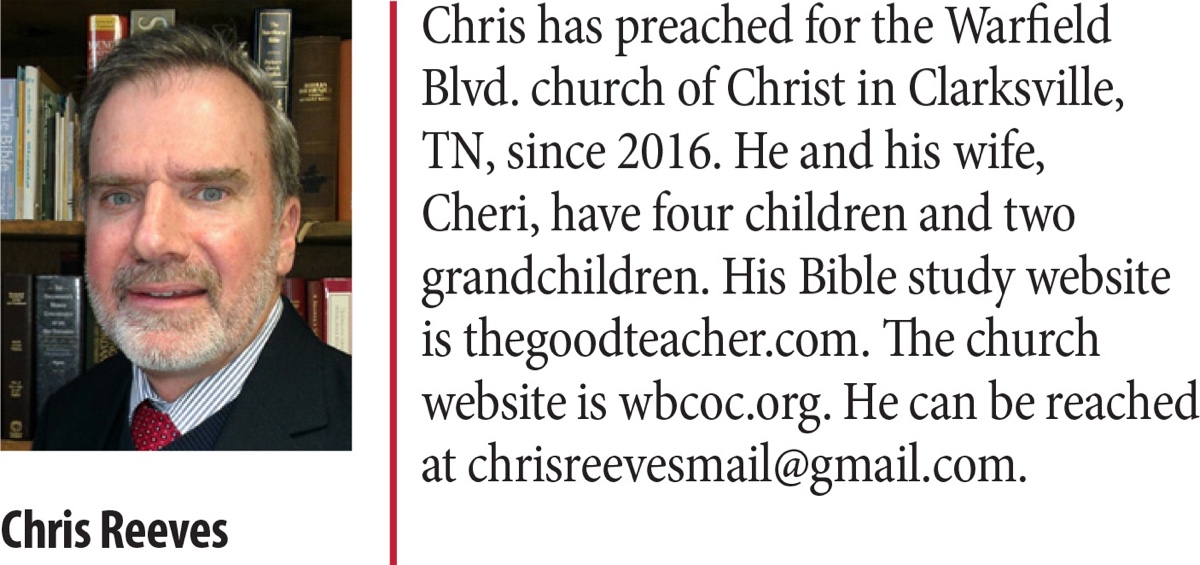By Chris Reeves
Synopsis: Bible class teachers in the local church of all ages need a reminder that teaching the text of the Bible is the primary work of a class teacher. It is easy to get side-tracked on doing other things during the class period.
I appreciate all our Bible class teachers in the Lord’s church. When I was young, I had many good Bible class teachers, both men and women. I know the importance of such teaching both from my work as a gospel preacher and from being in classes of others who have taught me through the years. Indeed, the Scriptures are “profitable for teaching” (2 Tim. 3:16).
While I appreciate all our Bible class teachers today, I also see a need to remind brethren to focus on the Bible text itself and not focus on secondary things. If we are not careful, the secondary things (things meant to illustrate the Bible text) quickly become the primary things. Let’s face it. To teach a good Bible class properly, the teacher has to take time during the week to learn the biblical text. The teacher needs to study the context, facts, word meanings, etc. This takes time.
Yet, because many class teachers do not have time or make time to do all of this properly, they tend to fall back on the easy stuff, the class “filler” stuff. Teachers of the younger students can fall back on filling the time with activities and not the text. Teachers of the older students and adults can fall back on filling the time with conversations and “sharing” their thoughts about the Bible without learning what’s in the Bible. On the way to the church building, an unprepared teacher may think, “I can always do such-and-such to fill the time.” “I can always give my kids a coloring sheet or a crossword puzzle.” “We can always play Bible hang-man.” “We can always talk and share what we think about the Bible.” Etc.
Sometimes others in the local church do not know that teachers are unprepared because the teaching is done behind closed doors. The leaders do not know that their “teachers” are really not teaching. The parents do not know that their children are not being taught well. They just see their children coming out of the classroom with workbooks and handouts and think all is fine. The children, when they are young, do not know that they are not being taught. With this in mind, let me offer five practices that will help us to focus on teaching the Bible text.
Let me encourage all our Bible class teachers to spend some time during class reading the actual text of the Bible out loud. It is very good to hear the words of Scripture read clearly. No, this is not a waste of time. We are not trying to “kill some time” because we are unprepared. Rather, we are following a biblical precedent. Nehemiah 8 is a good example of this. In this instance, God’s word was first read out loud, then interpreted or explained, and then applied. Moreover, in 1 Timothy 4:13, we learn that “reading” God’s word is tied to “teaching” God’s word.
Remember, it is very possible that some students have not read the Bible before coming to class. Visitors may not have read or heard this text before. Others have forgotten it and some need a reminder. Let’s be honest and real, some students, young and old, come to class unprepared. For whatever reason, they have not read their lesson in the workbook and they have not read their Bible. At least while you have them with you for a few minutes each week, you can read the text of God’s word to them. Also, hearing God’s word from a different, literal-based translation can also be helpful. Teachers should read the Bible text in class. You can read and you can have your students read as well. Encourage each student to bring his own Bible, open it up, and read from it.
Let me encourage all our Bible class teachers to spend the majority of the class teaching and explaining the Bible text and spend less time reading from the workbook. Workbooks are good. I have written them and I use them. However, the workbook should be an aid, not the main thing. Encourage your students to fill out the workbook at home and even answer questions from it in class, but focus on the Bible text. What God says in the text, not what a human author says, is what is important. Remember, you are a Bible teacher (you explain what a Bible verse means), not a workbook coordinator (you make sure the students read from the workbook).
Let me encourage all our Bible class teachers to require their students to give Bible answers to Bible questions. I mean, the students need to answer with the specific wording that comes straight out of the text, not the generalized and paraphrased wording of the author in a workbook. One thing that is occurring today is that our students are learning to repeat what an author says, but they don’t know what the text of their Bible actually says. If they answer with the words of the author, fine, but encourage them to turn in their Bible and give the answer that comes directly out of the verse. Have them read the verse and then answer again with what the Bible says.
Let me encourage all our Bible class teachers to keep the students focused on the text of Scripture. It is very easy in a class to drift into generalized discussions about the Bible and not learn the meaning of the Bible text itself. Yes, give students the opportunity to make comments and ask questions. This is one way we learn. Nevertheless, keep the discussion focused on learning the Bible text. Sometimes a teacher has good intentions and he starts with the text, but the discussion soon goes astray with the teacher and students “sharing” for the rest of the class period. This is not using our class time wisely.
Let me encourage all our Bible class teachers to make practical, current, and daily applications from the Bible text each time in class. I have known of really good Bible class teachers who can explain the meaning of the text, but not apply it to the lives of their students today. We must do both. Read Nehemiah 8 again. God’s word was first read, then interpreted (i.e., explained), and then applied. Let us follow this same structure today in our classes. Make time for Bible reading (What does the text say?), Bible interpretation (What does the text mean?), and Bible application (What does the text mean for us today?) in each class period.
Am I opposed to classroom activities, workbooks, and discussions that help illustrate the lessons of a particular Bible text? Of course not. They are helpful, especially in the younger grades. However, each Bible class teacher needs to focus on teaching the Bible text. Remember, it’s Bible class, not activities class. It’s Bible class, not workbook class. It’s Bible class, not a chat session. If we have drifted from our primary goal and purpose as Bible teachers, let’s come back to the text of Scripture. I hope these five reminders will help all of our teachers us to do that.


